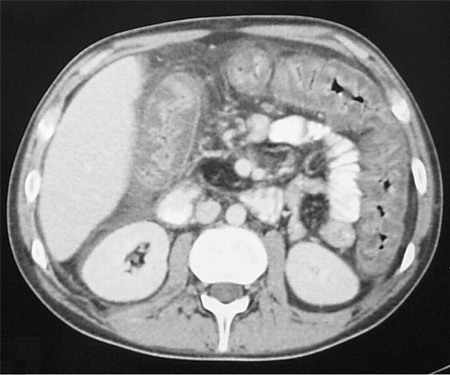Summary
Definition
History and exam
Key diagnostic factors
- რისკ-ფაქტორების არსებობა
- დიარეა
- მუცლის ტკივილი
Other diagnostic factors
- ცხელება
- მუცლის ტკივილი
- გულისრევა და ღებინება
- მუცლის შებერვა
- შოკის სიმპტომები
Risk factors
- ანტიბიოტიკების გავლენა
- ხანდაზმული ასაკი
- ჰოსპიტალიზაცია ან მოხუცთა თავშესაფარში ცხოვრება
- ოჯახის ინფიცირებულ წევრთან ექსპოზიცია
- - Clostridium difficile-თან დაკავშირებული დაავადების ანამნეზი
- მჟავიანობის დამაქვეითებელი პრეპარატების გამოყენება
- ნაწლავთა ანთებითი დაავადება
- პაციენტები, რომელთაც ჩაუტარდათ მყარი ორგანოების ტრანსპლანტაცია
- ჰემატოპოეზური ღეროვანი უჯრედების ტრანსპლანტის რეციპიენტები
- თირკმლის ქრონიკული დაავადება
- HIV ინფექცია
- იმუნოსუპრესიული მედიკამენტები ან ქიმიოთერაპია
- კუჭ-ნაწლავის ქირურგია
- D ვიტამინის ნაკლებობა
Diagnostic investigations
1st investigations to order
- FBC
- განავლის გვაიაკური სინჯი (განავლის ანალიზი ფარულ სისხლდენაზე)
- განავლის პოლიმერაზული ჯაჭვური რეაქცია (PCR)
- განავლის იმუნოლოგიური ანალიზი გლუტამატ დეჰიდროგენაზაზე
- განავლის იმუნოლოგიური ანალიზი A და B ტოქსინებზე
- მუცლის ღრუს რენტგენოგრაფია
Investigations to consider
- უჯრედული კულტურის ციტოტოქსიკურობის ნეიტრალიზაციის ანალიზი
- მუცლის კომპიუტერული ტომოგრაფიით
- სიგმოიდისკოპია ან კოლონოსკოპია
Emerging tests
- განავლის ლაქტოფერინი ან კალპროტექტინი
Treatment algorithm
საწყისი ეპიზოდი: არა მძიმე
საწყისი ეპიზოდი: მძიმე
საწყისი ეპიზოდი: ელვისებრი
პირველი რეციდივი
შემდგომი რეციდივი
Contributors
Authors
Ali Hassoun, MD, FACP, FIDSA, AAHIVS
Clinical Associate Professor of Medicine
Alabama Infectious Diseases Center
Huntsville
AL
Disclosures
AH declares that he has no competing interests.
Peer reviewers
Julius Atashili, MD, MPH
Department of Epidemiology
Division of General Medicine and Epidemiology
UNC at Chapel Hill
Chapel Hill
NC
Disclosures
JA declares that he has no competing interests.
Satish Keshav, MBBCh, DPhil, FRCP
Consultant Gastroenterologist
Department of Gastroenterology
John Radcliffe Hospital
Oxford
UK
Disclosures
SK declares that he has no competing interests.
Ian Beales, MD, FRCP
Clinical Reader and Consultant Gastroenterologist
Norfolk and Norwich University Hospital
Norwich
UK
Disclosures
IB declares that he has no competing interests.
Peer reviewer acknowledgements
BMJ Best Practice topics are updated on a rolling basis in line with developments in evidence and guidance. The peer reviewers listed here have reviewed the content at least once during the history of the topic.
Disclosures
Peer reviewer affiliations and disclosures pertain to the time of the review.
References
Key articles
McDonald LC, Gerding DN, Johnson S, et al. Clinical Practice Guidelines for Clostridium difficile Infection in Adults and Children: 2017 Update by the Infectious Diseases Society of America (IDSA) and Society for Healthcare Epidemiology of America (SHEA). Clin Infect Dis. 2018 Mar 19;66(7):e1-e48.Full text Abstract
Johnson S, Lavergne V, Skinner AM, et al. Clinical practice guideline by the Infectious Diseases Society of America (IDSA) and Society for Healthcare Epidemiology of America (SHEA): 2021 focused update guidelines on management of Clostridioides difficile infection in adults. Clin Infect Dis. 2021 Jun 24:ciab549.Full text Abstract
van Prehn J, Reigadas E, Vogelzang EH, et al. European Society of Clinical Microbiology and Infectious Diseases: 2021 update on the treatment guidance document for Clostridioides difficile infection in adults. Clin Microbiol Infect. 2021 Dec;27 Suppl 2:S1-S21.Full text Abstract
Beinortas T, Burr NE, Wilcox MH, et al. Comparative efficacy of treatments for Clostridium difficile infection: a systematic review and network meta-analysis. Lancet Infect Dis. 2018 Sep;18(9):1035-44. Abstract
Nelson RL, Suda KJ, Evans CT. Antibiotic treatment for Clostridium difficile-associated diarrhoea in adults. Cochrane Database Syst Rev. 2017;(3):CD004610.Full text Abstract
Reference articles
A full list of sources referenced in this topic is available to users with access to all of BMJ Best Practice.

Differentials
- ანტიბიოტიკებით გამოწვეული დიარეა (AAD)
- იშემიური კოლიტი
- ბაქტერიული ან ვირუსული გასტროენტერიტი
More DifferentialsGuidelines
- Japanese clinical practice guidelines for management of Clostridioides (Clostridium) difficile infection
- Management of Clostridioides difficile infection (CDI) in hematopoietic cell transplant patients
More GuidelinesLog in or subscribe to access all of BMJ Best Practice
Use of this content is subject to our disclaimer